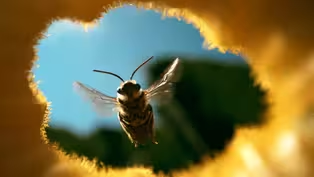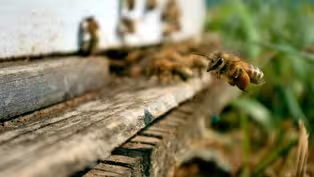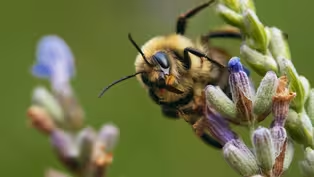
The Secret Life of Squash Bees
Clip: Season 2 Episode 4 | 9m 58sVideo has Closed Captions
Margarita Lopez-Uribe reveals how squash bees evolved to thrive on our modern farms.
Pollination gets personal when Shane meets Margarita Lopez-Uribe, an entomologist who studies squash bees — a wild, solitary species with a deep evolutionary bond to agriculture. These high-speed pollinators rely solely on cultivated squash to survive, revealing how humans and bees have co-evolved for millennia — and what their survival means for the future of farming.
Problems playing video? | Closed Captioning Feedback
Problems playing video? | Closed Captioning Feedback

The Secret Life of Squash Bees
Clip: Season 2 Episode 4 | 9m 58sVideo has Closed Captions
Pollination gets personal when Shane meets Margarita Lopez-Uribe, an entomologist who studies squash bees — a wild, solitary species with a deep evolutionary bond to agriculture. These high-speed pollinators rely solely on cultivated squash to survive, revealing how humans and bees have co-evolved for millennia — and what their survival means for the future of farming.
Problems playing video? | Closed Captioning Feedback
How to Watch Human Footprint
Human Footprint is available to stream on pbs.org and the free PBS App, available on iPhone, Apple TV, Android TV, Android smartphones, Amazon Fire TV, Amazon Fire Tablet, Roku, Samsung Smart TV, and Vizio.
Buy Now

Surprising Moments from Human Footprint
Do you think you know what it means to be human? In Human Footprint, Biologist Shane Campbell-Staton asks us all to think again. As he discovers, the story of our impact on the world around us is more complicated — and much more surprising — than you might realize.Providing Support for PBS.org
Learn Moreabout PBS online sponsorship(whooshing) (mysterious music) (Margarita) I call squash bees, like, caffeinated bees... -Okay.
-...because they fly so fast that you can barely see them.
(Shane) They have a very Type A personality.
-Yes!
-Okay.
-That’s why we get along.
-Okay.
(laughing) Okay.
(woman) ♪ Lit, lit ♪ (hip-hop music) (Shane) Meet Margarita López-Uribe.
(whooshing) ("Für Elise" by Beethoven) She loves the piano almost as much as she loves bees.
♪ Almost.
-(woman) Ow!
-(hip-hop music) (Shane) At Penn State’s Frost Entomological Museum, Margarita gave me a crash course in bee biology.
(woman) ♪ Somebody do it like me ♪ ♪ What makes a bee a bee?
(Margarita) That’s actually not a trivial question.
(soft music) It’s really, really hard to sometimes differentiate bees from related wasps.
♪ (Shane) But there’s one big difference.
Bees feed their babies with pollen and nectar.
Their wasp ancestors fed their young other insects.
(bee buzzing) So, bees are basically wasps that went vegetarian more than 100 million years ago.
(bee tarsomeres pattering) And that lifestyle change has made them pretty successful.
(whooshing) How many species of bee are there in North America?
About 4,000.
That’s a lot of bees.
And if you ask Margarita, most of those 4,000 species don’t get their due.
So, if bees were NSYNC, honey bees would be like Justin Timberlake and then the rest, they’re there but nobody’s paying as close attention to them.
Exactly, yes.
(mellow music) ♪ There is a lot of diversity.
♪ (bees buzzing) (Margarita) Most bees are definitely not like honey bees.
♪ (bee buzzing) (Shane) To start with, most bees don’t live in colonies.
(bees buzzing) Only about one in ten bee species are social.
-(mysterious music) -(bee buzzing) Most are solitary, with individual females building nests in soil, wood, and other materials.
(soil swooshes) For more than a decade, Margarita’s been digging into the story of one solitary species, and its unexpected connection with us.
What is a squash bee?
(Margarita) They are about a honey bee size.
But if you look closely, they are quite different.
(bee buzzing) (buzzing distorts) Squash bees have these very long hairs that are actually adapted to the very large and spiky pollen grains of the squash plants.
-(bee buzzing) -(soft music) (Shane) This adaptation to one kind of pollen sets them apart from honey bees.
(Margarita) Honey bees are generalists.
They use a lot of different types of plants to feed their babies.
Squash bees are highly specialized.
They only use the pollen from one plant genus, and that plant genus happens to be domesticated and used for agriculture.
(mellow music) (Shane) Here in Pennsylvania, seeing squash bees in their element means heading to a pumpkin farm in Amish country.
(Margarita) Hey!
Here you go.
♪ (Shane) So, what is the difference between how bees use pollen versus nectar?
(Margarita) So, the nectar is giving the developing larvae energy and the pollen is primarily protein and lipids.
(Shane) It’s a daily balanced breakfast.
(Margarita laughs) Watching the squash bees, you start to notice how different they are from honey bees.
For one thing, a lot of these bees are males.
(tense music) ♪ (Margarita) The males usually emerge first.
They need to do two things.
They need to find energy.
(bee buzzing) (Margarita) And they need to find mates.
(bees buzzing) (Shane) Once the females emerge, they spend almost as much time fighting off over-excited males as they do collecting food.
♪ (Shane) And every female has another huge job to do: digging a nest for her babies.
(wings flapping) (soft music) (Margarita) Imagine yourself, you know, removing all of that soil from the ground, right?
Like to dig something like half a meter deep.
(mellow music) (Shane) Of course, the males aren’t helping at all.
(Margarita) Oh, no, no, they are not in the nest at all.
Every single time.
Squash bees share these fields with honey bees and bumblebees.
(Margarita) You see how clumsy they are compared to squash bees, which are, you know, like, very precise.
(Shane) Seems a little judgmental but that’s--that’s fine.
(Margarita) Okay.
(bee buzzing) (Shane) Even in a world filled with busy bees, squash bees stand out.
They’re laser-focused on the task at hand, whether that’s building a nest and provisioning babies, or trying to mate with anything that moves... bumble bees included.
♪ There’s a reason all these bees are here.
Pumpkin flowers are a great source of nectar.
But their pollen, that’s a different story.
♪ (Margarita) Squash plants have, you know, very large, spiky pollen that is not easy to digest for bees, right?
Oh!
Okay.
♪ That might seem counterintuitive, but a lot of plants have adaptations to protect their pollen.
Because they don’t want pollinators to eat it, just move it from one flower to another.
(bee buzzing) Squash pollen can actually damage a baby bee’s digestive tract.
♪ So, most species clean themselves to avoid bringing the weapons-grade pollen back to their nests.
♪ But squash bees can’t get enough.
(audible chewing) Researchers still don’t understand exactly how they can eat squash pollen without any ill effects, but they’ve been doing it for a long time.
(soft music) Squash bees and squashes lived side-by-side in Mexico and the desert Southwest for at least eight million years before humans showed up.
(energetic music) Then, everything changed.
♪ (narrator) Planting seeds of squash.
(hip-hop music) (Margarita) The first evidence of domestication of a squash was in Mexico about 10,000 years ago.
♪ (Shane) People used these early squashes as storage vessels and fishing floats, and sometimes ate the seeds.
♪ This knowledge spread, along with the plants themselves.
I imagine it’s pretty good news for squash bees.
Absolutely.
(Shane) Margarita and her colleagues analyzed squash bee DNA to learn more.
(Margarita) In addition to the range expansion, we see a population expansion.
(Shane) About a thousand years ago, the bees’ population started growing exponentially; just as Indigenous Americans began growing squash, beans, and maize, the so-called "three sisters," at larger scales.
(mysterious music) The DNA also revealed something unusual happening here, in the Northeast.
(Margarita) 20% of the protein coding genes show signatures of positive selection, right?
-So, it’s-- -Wow.
Yeah, it’s a very strong signature.
(Shane) The genetic work uncovered telltale signs of recent natural selection in these bees.
The question is, natural selection for what?
♪ (Margarita) There is something interesting happening with the sensory system of the bees.
We don’t know exactly what that means yet, but... (Shane) Okay.
But Margarita has some ideas.
The Northeastern U.S. doesn’t have native squash plants, so squash bees followed ancient farmers here and, today, rely completely on cultivated squash, which produce a different cocktail of odors than their wild ancestors did.
♪ How does one go about figuring out how a bee smells?
(Margarita) We are using a technique called electroantennograms.
(Shane) The researchers isolate airborne chemicals from squash flowers, both wild and domestic, and use them to test the sensitivity of squash bee antennae.
♪ It’s a step toward discovering whether squash bees have evolved to locate cultivated squash flowers, which move from year to year as farmers rotate their crops.
♪ However they’re doing it, it’s clear that squash bees can thrive on our farms, which is good news.
(Margarita) We know that agriculture, per se, is not bad for bees.
We have the example of the squash bees, right?
Like they thrive in agricultural settings.
But the intensification of agriculture is definitely not good for, like, any bees.
(hip-hop music) (Shane) All too often, modern agriculture means vast monocultures, powerful pesticides, and constant disturbance.
♪ Three strikes against bees.
(bee buzzing) But our food system also can’t function without them.
(bees buzzing) So, to keep food on the shelves, we’re pushing our partnerships with bees to the limit.
Video has Closed Captions
Preview: S2 Ep4 | 30s | Shane investigates the future of bees, from honey bees to wild native species, in a changing world. (30s)
The Pollination Economy: Inside America's Bee Crisis
Video has Closed Captions
Clip: S2 Ep4 | 12m 42s | Shane meets the beekeepers and scientists racing to save America's pollination workforce. (12m 42s)
Rusty-Patched Rescue: Saving America's Wild Bees
Video has Closed Captions
Clip: S2 Ep4 | 4m 11s | Clay Bolt and Shane trace the decline of wild bees — and fight to bring them back. (4m 11s)
Providing Support for PBS.org
Learn Moreabout PBS online sponsorship
- Science and Nature

Explore scientific discoveries on television's most acclaimed science documentary series.

- Science and Nature

Capturing the splendor of the natural world, from the African plains to the Antarctic ice.












Support for PBS provided by:


